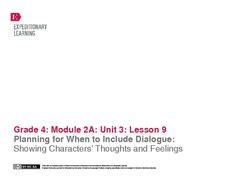Curated and Reviewed by
Lesson Planet
This Planning for When to Include Dialogue: Showing Characters’ Thoughts and Feelings lesson plan also includes:
- Grade 4 ELA Module 2A, Unit 3 - Full Unit
- Grade 4 ELA Module 2A, Unit 3 - Recommended Texts
- Grade 4 ELA Module 2A, Unit 3 - Assessment Overview
- Grade 4 ELA Module 2A, Unit 3 - Performance Task
- Grade 4 ELA Module 2A - Full Module
- EngageNY Resources (.html)
- Planning for When to Include Dialogue: Showing Characters’ Thoughts and Feelings (.docx)
- Unit Overview (.pdf)
- Unit Overview (.docx)
- Recommended Texts (.pdf)
- Recommended Texts (.docx)
- Module Overview (.pdf)
- Module Overview (.docx)
- Module Assessments (.pdf)
- Module Assessments (.docx)
- Module Performance Task (.pdf)
- Module Performance Task (.docx)
- Reading Passage
- Join to access all included materials
Young writers examine dialogue conventions, including indentation, quotation marks, and expressing thoughts and feelings through a fictional text. By noticing where and when authors use dialogue, they decide how to incorporate dialogue into their historical fiction narrative writing pieces. The teacher first models this concept, and then classmates work collaboratively to plan where to put their dialogue.
45 Views
32 Downloads
CCSS:
Designed
Concepts
Additional Tags
Instructional Ideas
- Add completed work to individual work folders to keep everything organized
- Introduce dialogue with speech bubbles in comic strips
Classroom Considerations
- Provide highlighters and blue colored pencils for learners to revise their drafts
- This is the ninth in a series of 16 lessons that help learners write historical fiction narratives
- You'll need to prepare a writing dialogue anchor chart on poster paper
Pros
- Common Core designed
- Includes detailed lesson procedures, guiding questions, required materials, homework ideas, and reproducibles
Cons
- None



